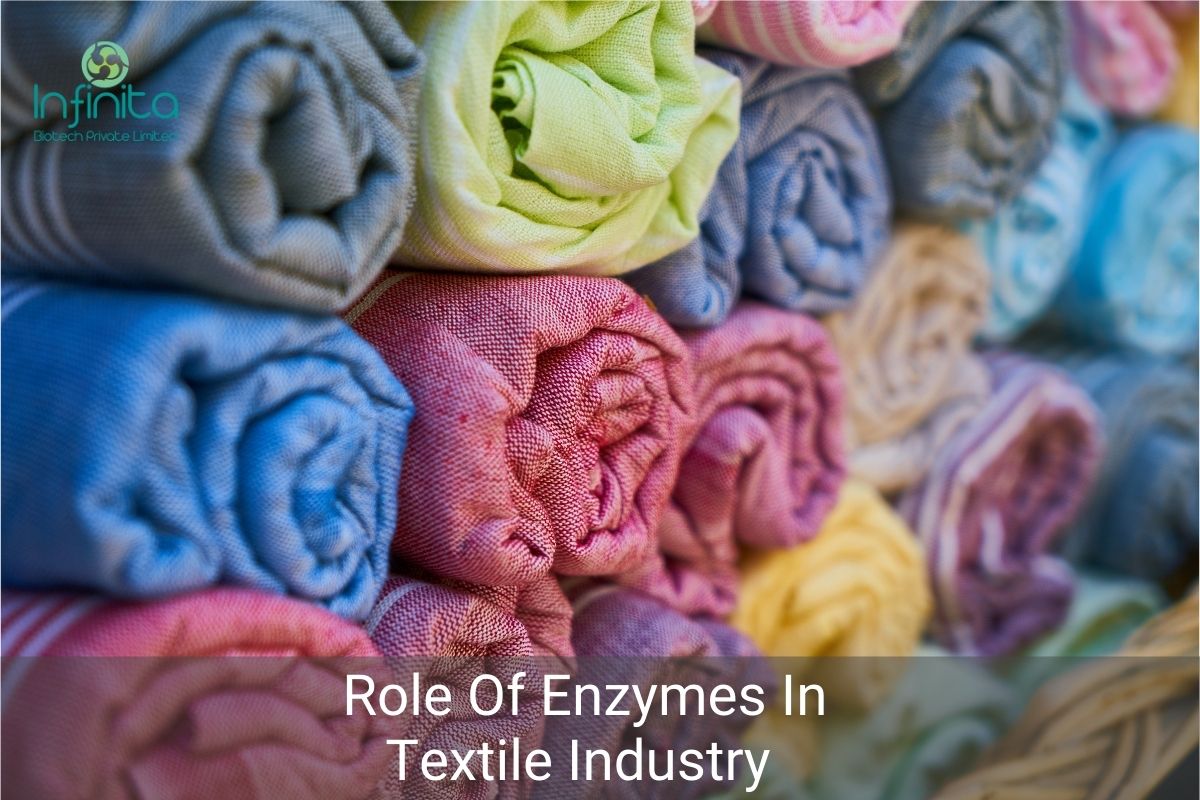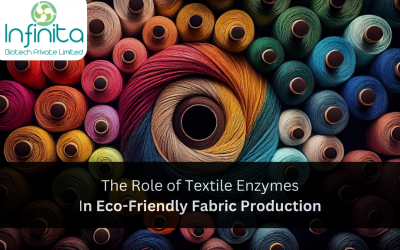
What Is The Role Of Enzyme In Textile Industry?
Role Of Enzymes In Textile Industry
Enzymes, for example, cellulases, catalase, and laccase are typically utilised in the textile business. These enzymes are accustomed to eliminating the starch, debasing abundance hydrogen peroxide, dying materials and corrupting lignin. Due to the exceptionally explicit, productive, non-poisonous, and eco-accommodating attributes, the utilisation in the textile business’s of enzymes is quickly developing.
Moreover, enzymes’ utilisation brings about decreased cycle times, energy and water investment funds, improved item quality.
Properties Of Enzymes Used In The Textile Industry
The enzyme stimulates the reaction by reducing the activation energy and stays unchanged by acting as a catalyst at the end of the reaction. Secondly, enzymes function in a milder state. Enzymes can be used at low temperatures at catalytic concentrations and near-neutral pH levels. Thirdly, enzymes are the best alternative to chemical compounds that are poisonous, harmful and pollutant. Fourth, enzymes only function on particular substrates, such as, enzymes that are used to polymerize do not affect cellulose, so the loss is not observed there. Fifth, since their activity is conditionally optimized, the enzymes are simple to regulate. Sixth, biodegradable enzymes, when the reaction finishes, the remaining solution can be drained by the enzymes in use simply because the enzymes are biodegradable without causing any harmful wastes from degradation.
What Is A Textile Enzyme?
Enzymes are bio-forces and are used in a couple of mechanical systems since the nineteenth century. Due to their non-destructive and Eco-obliging credits, have expanded wide applications in the textile industry.
Financially impetuses can be gained from three fundamental sources such as animal tissues, microorganisms, and plants. In any case, these typically happening impetuses are not developed in satisfactory adds up to be immediately used in current applications. In this manner, microbial strains conveying the ideal compound are refined and improved for instance development, to secure proteins in satisfactory sums for their corporate utility in the material business. The enzymes used in the material business are amylases, cellulases, pectinases, lipases, catalases, proteases, xylanases, etc. They are generally used to treat the materials, for instance, fundamental and finishing of the items. A part of the applications consolidates clearing of starch, whitening, degrading lignin, obscuring denim and non-denim, removing peroxidises, finishing wool, and decolouration of dyestuff, bio-cleaning, bio-scouring, and smooth finishing, etc.
What Is The Role Of Enzymes?
Use of biocatalysts in various material handling structures has benefitted the textile business concerning both ecological impact and nature. There are 7000 known enzymes, yet only 75 are modernly used in the textile business, and by far most of them have a spot with hydrolases and oxidoreductases families. The hydrolases family joins amylases, cellulases, pectinases, proteases, catalases and lipases/esterases and oxidoreductase family fuse laccase, peroxidase.
Amylases
Amylases follow up on starch particles and hydrolyse to give dextrin and little polymers of glucose units. These are assembled by the sugars they make, for instance, α-amylases and β-amylases. α-Amylases being made from filamentous parasites and microorganisms are generally used in ventures.
These biocatalysts are consistent over a vast extent of pH from 4-11, and ideal activity is related to the source microorganisms’ advancement conditions. With everything taken into account, α-Amylases show’s high distinction towards starch followed by amylase, amylopectin, cyclodextrin, glycogen and maltotriose.
Textile Desizing Use
Size is a tacky element used to cover the wrapping strings used in the weaving process of the textures delivered utilising cotton or mix. Starch and its auxiliaries are completely utilised to estimate textures because of their straightforward openness, moderately minimal effort and excellent film creating limit. Amylases are what helps in the removal of the evaluating material and set the texture for colouring and wrapping up.
Preceding amylases’ disclosure, desizing was done by compound treatment of the surface with destructive, salt or oxidising experts at a high temperature. In any case, this process was inefficient in ousting the starch which achieved abandons in shading and besides debasement of cotton fibre. Amylases are economically used for desizing surface due to its effectiveness and expression and suitability in absolutely ousting the size without impacting the texture. Starch is cleared during washing as water dissolves dextrin and reduces the arrival of compound waste into the climate.
Cellulases
Cellulases are hydrolytic intensifies that catalyse the breakdown of cellulose to smaller oligosaccharides and in conclusion to glucose. Soil-standing developments normally make these compounds and microorganisms, such as Penicillium, Trichoderma and Fusarium, and show ideal development in temperature go from 30C-60C. The usages of cellulases in the material business start in the latter part of the 19th century with denim wrapping up. This by itself addresses 14% of the world’s cutting edge synthetic market.
Denim Fishing
Denim is excellent cotton, and the washing happens in a way as to give an overall utilised look, for instance, stone washing of denim pants, in which a denim surface is blurred using sodium hypochlorite or potassium permanganate are used as pumice stones, and this bring loss to the surface and machine. The business creation of cellulases has extended the effectiveness without affecting textile or machine.
Cellulases hydrolyses the uncovered surface of hued (indigo) surface leaving the internal parts immaculate, deficient hydrolyses of a surface results into the ejection of shading and leaves behind a light territory. Nonetheless, cellulases from the bacterial and actinomycetes source are now focused on its usage in the bio-stoning process of denim. Moreover, Cellulases necessary for the washing of denim can also be requested depending on the ideal pH needed for its most noteworthy profitability; as nonpartisan cellulases working at pH 6-8 and acidic cellulases acting at pH 4.5-6.
Bio Finishing
The enzymatic development of cellulose to enhance the last beginner ends through the bio-finish or bio-cleaning processes, such as cotton washing and other regular or artificial cellulose surfaces, other than denim. The methodology helps to hinder the path of cushion wads called clothing pills outside. In general, this turns into a knotty surface look.
Cellulases hydrolyse the microfibrils distending from the surface’s external perspective, which will cut off, leaving behind a plain surface. Bio-completing may be a selective development for updating cotton surfaces, yet a considerable development fully expects fibrillation or pilling during lyocell surfaces. Cellulases comes with a gooey kind recuperated celluloses like thick and particular. The occupation of ultrasound is a successful strategy to enhance the enzymatic procedure in the bioprocessing of cotton.
As a result of constantly expanding poisons, assemblies of various countries are upholding stricter limitations on the arrival of poisons into the climate. There is reliably growing interested in clean systems such as measures that cause no pollution or minor defilement. Textile industry, particularly the synthetic handling division, reliably has a huge proposal in the overall tainting. Impetuses expect a vital occupation in such elective methodology. Use of proteins in material started as long as a century earlier. Today catalysts have become a vital piece of the material preparing. There are two grounded biocatalyst applications in the material business. At first, in the primer completing zone amylases are consistently used for desizing measure. Moreover, in the completing zone, cellulase is used to mellow, bio-stoning and diminish pilling liking for cotton items.
ALPHA AMYLASE
It can be applied for desizing.

Starch
Decomposition

Improves Weaving

Decrease Yarn
Breakage
CELLULASE
Biopolishing

Enhances
Fabric Quality

Improvement In
Pill Resistance

Brighter Luminosity
Of Colors
PECTOLYTIC ENZYME WITH CELLULOSE ACTIVITY
It break down starches and dextrins.

Removes Pectin

Removes Wax

Protein Hydrolysis
Related Articles
Enzyme Innovations: The Future of Textile Processing
In recent years, the textile industry has undergone significant transformations, driven by the pursuit of more sustainable and efficient production processes. One notable innovation that has garnered attention is the use of enzymes in textile processing. Enzymes, with...
The Environmental Advantages of Using Desize Enzymes in Textile Manufacturing
Textile Enzymes manufacturing is a significant industry worldwide, but it is also notorious for its negative environmental impact. The use of traditional chemicals in textile processing leads to water pollution, energy consumption, and a high carbon footprint....

What Is The Role Of Enzyme In Textile Industry?
Role Of Enzymes In Textile Industry
Enzymes, for example, cellulases, catalase, and laccase are typically utilised in the textile business. These enzymes are accustomed to eliminating the starch, debasing abundance hydrogen peroxide, dying materials and corrupting lignin. Due to the exceptionally explicit, productive, non-poisonous, and eco-accommodating attributes, the utilisation in the textile business’s of enzymes is quickly developing.
Moreover, enzymes’ utilisation brings about decreased cycle times, energy and water investment funds, improved item quality.
Properties Of Enzymes Used In The Textile Industry
The enzyme stimulates the reaction by reducing the activation energy and stays unchanged by acting as a catalyst at the end of the reaction. Secondly, enzymes function in a milder state. Enzymes can be used at low temperatures at catalytic concentrations and near-neutral pH levels. Thirdly, enzymes are the best alternative to chemical compounds that are poisonous, harmful and pollutant. Fourth, enzymes only function on particular substrates, such as, enzymes that are used to polymerize do not affect cellulose, so the loss is not observed there. Fifth, since their activity is conditionally optimized, the enzymes are simple to regulate. Sixth, biodegradable enzymes, when the reaction finishes, the remaining solution can be drained by the enzymes in use simply because the enzymes are biodegradable without causing any harmful wastes from degradation.
What Is A Textile Enzyme?
Enzymes are bio-forces and are used in a couple of mechanical systems since the nineteenth century. Due to their non-destructive and Eco-obliging credits, have expanded wide applications in the textile industry.
Financially impetuses can be gained from three fundamental sources such as animal tissues, microorganisms, and plants. In any case, these typically happening impetuses are not developed in satisfactory adds up to be immediately used in current applications. In this manner, microbial strains conveying the ideal compound are refined and improved for instance development, to secure proteins in satisfactory sums for their corporate utility in the material business. The enzymes used in the material business are amylases, cellulases, pectinases, lipases, catalases, proteases, xylanases, etc. They are generally used to treat the materials, for instance, fundamental and finishing of the items. A part of the applications consolidates clearing of starch, whitening, degrading lignin, obscuring denim and non-denim, removing peroxidises, finishing wool, and decolouration of dyestuff, bio-cleaning, bio-scouring, and smooth finishing, etc.
What Is The Role Of Enzymes?
Use of biocatalysts in various material handling structures has benefitted the textile business concerning both ecological impact and nature. There are 7000 known enzymes, yet only 75 are modernly used in the textile business, and by far most of them have a spot with hydrolases and oxidoreductases families. The hydrolases family joins amylases, cellulases, pectinases, proteases, catalases and lipases/esterases and oxidoreductase family fuse laccase, peroxidase.
Amylases
Amylases follow up on starch particles and hydrolyse to give dextrin and little polymers of glucose units. These are assembled by the sugars they make, for instance, α-amylases and β-amylases. α-Amylases being made from filamentous parasites and microorganisms are generally used in ventures.
These biocatalysts are consistent over a vast extent of pH from 4-11, and ideal activity is related to the source microorganisms’ advancement conditions. With everything taken into account, α-Amylases show’s high distinction towards starch followed by amylase, amylopectin, cyclodextrin, glycogen and maltotriose.
Textile Desizing Use
Size is a tacky element used to cover the wrapping strings used in the weaving process of the textures delivered utilising cotton or mix. Starch and its auxiliaries are completely utilised to estimate textures because of their straightforward openness, moderately minimal effort and excellent film creating limit. Amylases are what helps in the removal of the evaluating material and set the texture for colouring and wrapping up.
Preceding amylases’ disclosure, desizing was done by compound treatment of the surface with destructive, salt or oxidising experts at a high temperature. In any case, this process was inefficient in ousting the starch which achieved abandons in shading and besides debasement of cotton fibre. Amylases are economically used for desizing surface due to its effectiveness and expression and suitability in absolutely ousting the size without impacting the texture. Starch is cleared during washing as water dissolves dextrin and reduces the arrival of compound waste into the climate.
Cellulases
Cellulases are hydrolytic intensifies that catalyse the breakdown of cellulose to smaller oligosaccharides and in conclusion to glucose. Soil-standing developments normally make these compounds and microorganisms, such as Penicillium, Trichoderma and Fusarium, and show ideal development in temperature go from 30C-60C. The usages of cellulases in the material business start in the latter part of the 19th century with denim wrapping up. This by itself addresses 14% of the world’s cutting edge synthetic market.
Denim Fishing
Denim is excellent cotton, and the washing happens in a way as to give an overall utilised look, for instance, stone washing of denim pants, in which a denim surface is blurred using sodium hypochlorite or potassium permanganate are used as pumice stones, and this bring loss to the surface and machine. The business creation of cellulases has extended the effectiveness without affecting textile or machine.
Cellulases hydrolyses the uncovered surface of hued (indigo) surface leaving the internal parts immaculate, deficient hydrolyses of a surface results into the ejection of shading and leaves behind a light territory. Nonetheless, cellulases from the bacterial and actinomycetes source are now focused on its usage in the bio-stoning process of denim. Moreover, Cellulases necessary for the washing of denim can also be requested depending on the ideal pH needed for its most noteworthy profitability; as nonpartisan cellulases working at pH 6-8 and acidic cellulases acting at pH 4.5-6.
Bio Finishing
The enzymatic development of cellulose to enhance the last beginner ends through the bio-finish or bio-cleaning processes, such as cotton washing and other regular or artificial cellulose surfaces, other than denim. The methodology helps to hinder the path of cushion wads called clothing pills outside. In general, this turns into a knotty surface look.
Cellulases hydrolyse the microfibrils distending from the surface’s external perspective, which will cut off, leaving behind a plain surface. Bio-completing may be a selective development for updating cotton surfaces, yet a considerable development fully expects fibrillation or pilling during lyocell surfaces. Cellulases comes with a gooey kind recuperated celluloses like thick and particular. The occupation of ultrasound is a successful strategy to enhance the enzymatic procedure in the bioprocessing of cotton.
As a result of constantly expanding poisons, assemblies of various countries are upholding stricter limitations on the arrival of poisons into the climate. There is reliably growing interested in clean systems such as measures that cause no pollution or minor defilement. Textile industry, particularly the synthetic handling division, reliably has a huge proposal in the overall tainting. Impetuses expect a vital occupation in such elective methodology. Use of proteins in material started as long as a century earlier. Today catalysts have become a vital piece of the material preparing. There are two grounded biocatalyst applications in the material business. At first, in the primer completing zone amylases are consistently used for desizing measure. Moreover, in the completing zone, cellulase is used to mellow, bio-stoning and diminish pilling liking for cotton items.
0 Comments
Submit a Comment
You must be logged in to post a comment.
ALPHA AMYLASE
It can be applied for desizing.

Starch Decomposition

Improves Weaving

Decrease Yarn Breakage
CELLULASE
Biopolishing

Enhances Fabric Quality

Improvement In Pill Resistance

Brighter Luminosity Of Colors
PECTOLYTIC ENZYME WITH
CELLULOSE ACTIVITY
It break down starches and dextrins.

Removes Pectin

Removes Wax

Protein Hydrolysis
Enzyme Innovations: The Future of Textile Processing
In recent years, the textile industry has undergone significant transformations, driven by the pursuit of more sustainable and efficient production processes. One notable innovation that has garnered attention is the use of enzymes in textile processing. Enzymes, with...
The Environmental Advantages of Using Desize Enzymes in Textile Manufacturing
Textile Enzymes manufacturing is a significant industry worldwide, but it is also notorious for its negative environmental impact. The use of traditional chemicals in textile processing leads to water pollution, energy consumption, and a high carbon footprint....
The Role of Textile Enzymes in Eco-Friendly Fabric Production
Textile enzymes play a crucial role in the production of eco-friendly fabrics. By utilizing the power of enzymes, textile manufacturers can reduce the environmental impact of fabric production while still maintaining high-quality products. In this article, we will...




0 Comments